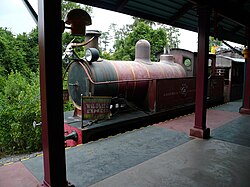Wildlife Express Train
| Wildlife Express Train | |
|---|---|
 Wildlife Express Locomotive | |
| Disney's Animal Kingdom | |
| Area | Africa Rafiki's Planet Watch |
| Coordinates | 28°21′35″N 81°35′28″W / 28.35972°N 81.59111°W |
| Status | Operating |
| Soft opening date | April 21, 1998 |
| Opening date | April 22, 1998 |
| Ride statistics | |
| Attraction type | Train |
| Manufacturer | Severn Lamb |
| Designer | Walt Disney Imagineering |
| Duration | 12:00 |
| Track gauge | 3 ft 4 in (1,016 mm) |
The Wildlife Express Train to Rafiki's Planet Watch is a short railroad that takes guests at Disney's Animal Kingdom from Harambe, Africa to Rafiki's Planet Watch (known as Conservation Station at the park). On the ride, guests get the chance to see a little of the Animal Kingdom backlot, including animal holding buildings for rhinos and elephants, among other animals. It takes about seven minutes to go from Harambe railway station, Africa to Rafiki's Planet Watch and an additional five to return. The full journey is a 1.2-mile (1.9 km) round-trip.
The railway is part of the fictional Eastern Star Railway, running from Lusaka to Nairobi and Kisangani.
Locomotives
Wildlife Express Train | |||||||||||||||||||||||||||||||||||||||||||||||||||||||||||||||||||||||||||||||||||||||||||||||
|---|---|---|---|---|---|---|---|---|---|---|---|---|---|---|---|---|---|---|---|---|---|---|---|---|---|---|---|---|---|---|---|---|---|---|---|---|---|---|---|---|---|---|---|---|---|---|---|---|---|---|---|---|---|---|---|---|---|---|---|---|---|---|---|---|---|---|---|---|---|---|---|---|---|---|---|---|---|---|---|---|---|---|---|---|---|---|---|---|---|---|---|---|---|---|---|
| |||||||||||||||||||||||||||||||||||||||||||||||||||||||||||||||||||||||||||||||||||||||||||||||
There are three diesel-hydraulic, steam outline locomotives, built by Severn Lamb of Stratford-upon-Avon, United Kingdom in 1997 before the park's opening the following year.[1] Two are colored a reddish brown, while the third is colored green. The two red-brown locomotives have a G-pitched whistle, while the green locomotive has a very high B-to-F#-pitched whistle. They have a wheel configuration of 2-4-2 and are based on John Aspinall's 2-4-2T engines built for the Lancashire & Yorkshire Railway of England in 1898 at Horwich locomotive works, Lancashire. However, the builder's plates of the locomotives tell a different story, saying that the engines were built in 1926 by Beyer Peacock of Gorton Foundry, Manchester. Their numbers are 02594, 04982 and 00174, the former also being named, R. Baba Harpoor, in honour of Imagineer Bob Harpur.
The railway is built to a 3 ft 4 in (1,016 mm) narrow gauge,[1] a little wider than the 1,000 mm (3 ft 3+3⁄8 in) metre gauge that was used on East African railways. There are two sets of coaches forming the passenger rolling stock, each with five vehicles and each seating around 250 people. These sets include a series of bins on the top of the train that simulate cargo that passengers are taking with them. One set of coaches has these bins green and the other red. This is a way for easy identification between trains.
See also
- L&YR Class 5 - L&YR 2-4-2T designed by Aspinall and built at Horwich.
- Rail transport in Walt Disney Parks and Resorts
References
External links
- Operating amusement attractions
- Amusement rides introduced in 1998
- 3 ft 4 in gauge railways in the United States
- Africa (Disney's Animal Kingdom)
- Heritage railroads in Florida
- Rail transport in Walt Disney Parks and Resorts
- Railroads of amusement parks in the United States
- The Lion King in amusement parks
- Walt Disney World transit

